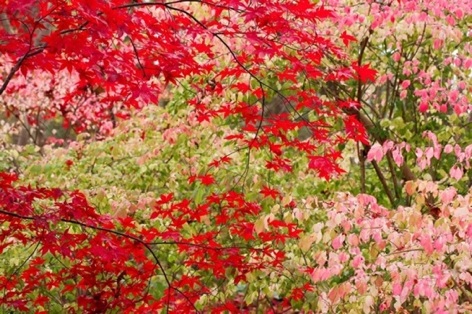Blazing the trail for autumn
A rich tapestry of colour should be enveloping our landscape over the next few weeks as leaves turn golden, orange and even red, thanks to a massive growth of foliage during the wet summer followed by cold nights.
The trees and other plants which will be providing us with magnificent hues include the maple and Japanese maple, native oak trees, Nyssa sinensis and Parrotia persica (Persian ironwood). The winter-flowering cherry, stag’s horn sumach, sorbus (wild mountain ash) and varieties of cornus can also paint a palette of vivid colours.
Following a wet summer, the recent warm weather has resulted in the production of lots of chlorophyll and increased sugar levels in trees. When the night-time temperature falls, it sends a message to the tree to stop growing and then the leaves will start turning, breaking down the chlorophyll to reveal autumnal pigments in shades of red, orange and yellow.
Venturing out on autumn walks may give you inspiration to grow some colourful specimens in your own garden. Maple, vine and mahonia leaves offer shades of red, while sedum flowerheads provide subtle russet tones which will stay on the plant well into winter.
In larger gardens use trees carefully so that their rich hues are a highlight rather than just a small part of an extremely busy planting scheme. Keep green as your main colour in the garden, as if you cram it with coloured foliage it can be far from restful.
Some trees take on more refined, subtle shades, such as yellow birch (Betula alleghaniensis) with its beautiful buttery yellow foliage, or the common beech (Fagus sylvatica), which turns a glorious shade of copper.
If you are going to plant a maple, avoid planting it in windy, exposed sites as its fragile leaves will be shredded. The best time to plant is autumn, when the soil is still warm, to give the trees time to establish before winter sets in.
Maples thrive in well-drained soil enriched with some well-rotted garden compost and will do well in full sun or dappled shape, and are ideal growing in the gentle shade of larger trees, provided their planting hole isn’t completely swamped with the roots of the larger specimen. Dig in leafmould to give the tree a boost. They shouldn’t need much pruning, just snip out any dead shoot tips as the buds begin to open in spring.
Here’s five of the best trees which you shouldn’t be without in autumn:
:: Cornus kousa ‘Satomi’: This amazing flowering dogwood offers something for every season. In autumn the leaves turn fiery red and orange, while large, deep-pink, star-shaped bracts appear in late spring. It also bears strawberry-like fruits in late summer that continue into winter.
:: Nyssa sinensis: The deciduous leaves on the Chinese tupelo provide a wide array of autumn colours, from mellow yellows to fiery reds. It thrives in acid soil and you’ll need to give it plenty of room as it grows up to 10m (30ft) in height and width.
:: Sorbus x ‘Joseph Rock: This popular small tree was introduced to the west after it was found in China in the early 20th century by the famed plant hunter, Joseph Rock. This Chinese mountain ash has cool green, feather-like leaves which turn fabulous shades of blood red in autumn before falling. Its stunning autumn colour is complimented by large clusters of bright yellow fruit.
:: Euonymus europaeus ‘Red Cascade’: Seen either as a shrub or trained as a small tree, this form of our native hedgerow spindle boasts a combination of bright red autumn foliage, turning purple as it ages, which colours at the same time as its generous crops of red and orange fruits. It’s an adaptable plant, happy in most reasonable soils in sun or light shade and growing to 3m (10ft).
:: Katsura (Cercidiphyllum japonicum): The heart-shaped green leaves of this dainty woodland tree turn to rich colours of yellow, orange and red leaves in autumn and produce the sweet scent of caramel or candyfloss as they fall. This tree, which works well as a stand-alone specimen, should be planted in soil enriched with organic matter in a sheltered spot, as the coppery young leaves are prone to spring frost damage.
Are you lucky enough to have any of these growing in your garden?
Latest posts by Sally - Silversurfer's Editor (see all)
- Will you be sending Christmas cards this year? - November 23, 2024
- Do you like the new Jaguar rebrand? - November 21, 2024
- Christmas Decorations Masterclass: Make your own Festive Wreath, Garland and Flower Centrepieces - November 21, 2024
- Finding warmth in cold days - November 21, 2024
- Fall in love with Norfolk Hideaways - November 20, 2024





















